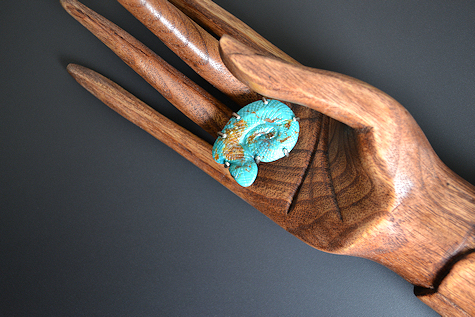This little rattlesnake didn't seem to want to be a necklace pendant, so he sat on my table with the other carvings for a while until I realized he wanted to cuddle up as a brooch. The hint of an 'S' curve in his neck indicates he is wary though not in attack mode. (The Rattlesnake Museum has a very interesting illustration of the movements a rattler makes as it strikes.) Apparently Madeleine Albright's Read My Pins (see below) diplomatic strategy began with a snake pin. Text on the book flap says, "It would never have happened if not for Saddam Hussein. When U.S. ambassador to the United Nations Madeleine Albright criticized the dictator, his poet in residence responded by calling her "an unparalleled serpent." Shortly thereafter, while preparing to meet with Iraqi officials, Albright pondered: What to wear? She decided to make a diplomatic statement by choosing a snake pin. Although her method of communication was new, her message was as old as the American Revolution—Don't Tread on Me."
According to McManis, at Zuni snakes are associated with lightning. Old examples were often plumed or water serpents, but today the rattlesnake is most often depicted. In the Medicine Cards, snake is given the attribute of transmutation (the snake sheds its skin and is distinguished from the total transformation of the caterpillar to butterfly). Sams and Carson mention that when snake energy reaches the spiritual plane it becomes wisdom, understanding, wholeness and connection to the Great Spirit. Andrews takes the pit viper's ability to sense the warmth of its prey as symbolic of a sensitivity to auras.
And, since I'm not shy about offering truly "out there" hypotheses, I've been having a look at Laird Scranton's work on the symbols and language of the Dogon people. My interest was piqued by Malidoma's mention that his Dagara people received their ancient wisdom from visitors from Sirius B, an invisible companion to Sirius which was not discovered by Western astronomers until 1862. The Dogon also trace their wisdom to these visitors. However, tmclark.com observes, "The Dogon people, in what is now Mali, may have held an interesting belief. In the early 1930's, it was recorded that these people believed that the star Sirius had an invisible companion, made of a metal which could not be found on Earth... [They] may have been informed of Sirius B by a team of anthropologists who had met with the Dogons a few years earlier." Perhaps. This potentially "convenient explanation" (to use don Juan's most excellent term) doesn't explain the fascinating observations Scranton has made relating Egyptian heiroglyphs and related Dogon symbols, words, stories and scientific knowledge to modern particle physics, quantum mechanics and string theory. OK, what on earth has all this to do with our little rattler? Scranton mentions that "The serpent symbol is perhaps the single most pervasive and persistent image of the oldest world mythologies." He describes the creation tradition of Hermopolis in ancient Egypt in which pairs of serpents and frogs create the cosmic egg (is it a coincidence that I suddenly decided to make both a serpent and a frog brooch?). The Egyptian falcon glyph (tchet), "the Divine Word," contains a serpent. The snake wiggles his way through both the Scranton books shown below in a fascinating way, but I'll leave further study to you should you have an interest.
Whether you believe in extraterrestrials or not, whether you have an interest in archaic snake symbolism or not, whether you want to say "don't tread on me!" or reflect upon cosmic mysteries, I hope you will order this beautiful little snake and enjoy his whisperings from your shoulder!







